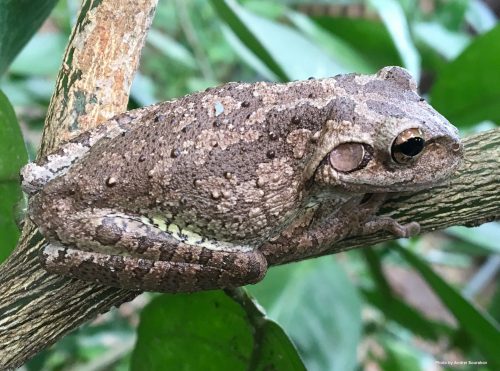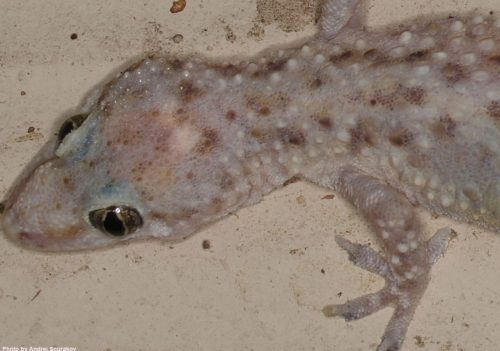The frogs and the geckos are well adapted to walking on glass. Windows present a perfect hunting ground for moths, and these animals sometimes cross paths, as both hunt by night. In this video, one such encounter is shown. The gecko withdrew, but got the prize moth both were eying.
About the video and animals in it:
Here in Florida, all of us, with vertebra or without, are aliens, although most are not of the first generation and many have lost their ancestral memory. The ancestors of the species that live here today began to arrive from the “florid-less” North American continent when Florida surfaced from beneath the ocean about 30 million years ago. The ancestors of those migrants in turn came from the parental supercontinents of Pangea and Laurasia and on and on…
Today as before, new inhabitants continue to arrive in Florida one way or another: some over land, some fly in with hurricane winds, some drift in on dead wood over the ocean. More and more, however, come on cargo ships, planes, and trucks. Regardless of the mode of transportation, the newcomers continue to play out various scenarios of adaptation, competition, and extinction, all of which existed perfectly well without Darwin’s help for over three billion years and will continue to do so long after the last Darwinist and his opponent die out.
While it is predominantly the extinction scenario that plays out, sending newcomers “to meet their ancestors,” many species put down roots but keep a low profile, blending in with the “natives” in many of Florida’s constantly evolving ecosystems. Some, species, however, due to lack of competition and natural enemies proliferate considerably. Then we begin to call them names like “invasives” and “exotics” and, if they annoy us too much, we combine the two and call them “invasive exotics.” Sometimes, we start a war on one or another species, which we mostly lose unless we find allies among native or exotic natural enemies.


Two such relatively recent immigrants are the Cuban Tree Frogs and the Mediterranean House Geckos. While the former we declared personas non grata due to their ferocious appetite and ability to multiply, the cute and modest geckos we tolerate much better. Both species can be best observed hunting insects at night around porch lights and on windows. Along with another “invasive exotic,” the Brown Anole, they have become staples of many Florida backyards. All three species, while opportunistic hunters, have a soft spot for moths, mostly because moths are stupefied by the lights and can sit by them till dawn and even for a couple of hours after sunrise. The anoles hunt for moths left at the lights in the morning and mostly avoid competition with the two other species, even though Cuban Tree Frogs are known to eat an anole or two.
While geckos eat almost exclusively insects, their remains have been found in the stomach of Cuban Treefrogs and predation has been observed on a number of occasions (see references below). So, perhaps the interaction shown in the video presented here, describes less of a competition, but more of a predator-prey interaction, in which the potential prey (gecko) managed to escape being swallowed by the frog.
References
Glorioso, B.M., Waddle, J.H., Crockett, M.E., Rice, K.G. and Percival, H.F., 2010. Diet of the invasive Cuban Treefrog (Osteopilus septentrionalis) in pine rockland and mangrove habitats in South Florida. Caribbean Journal of Science, 46(2–3), pp.346-355.
Owen, J.L., 2005. The Cuban tree frog (Osteopilus septentrionalis): distribution, diet, and reproduction of an invasive species in the British Virgin Islands (Doctoral dissertation, Texas Tech University).
Punzo, F., 2001. The Mediterranean gecko, Hemidactylus turcicus: life in an urban landscape. Florida Scientist, pp.56-66.